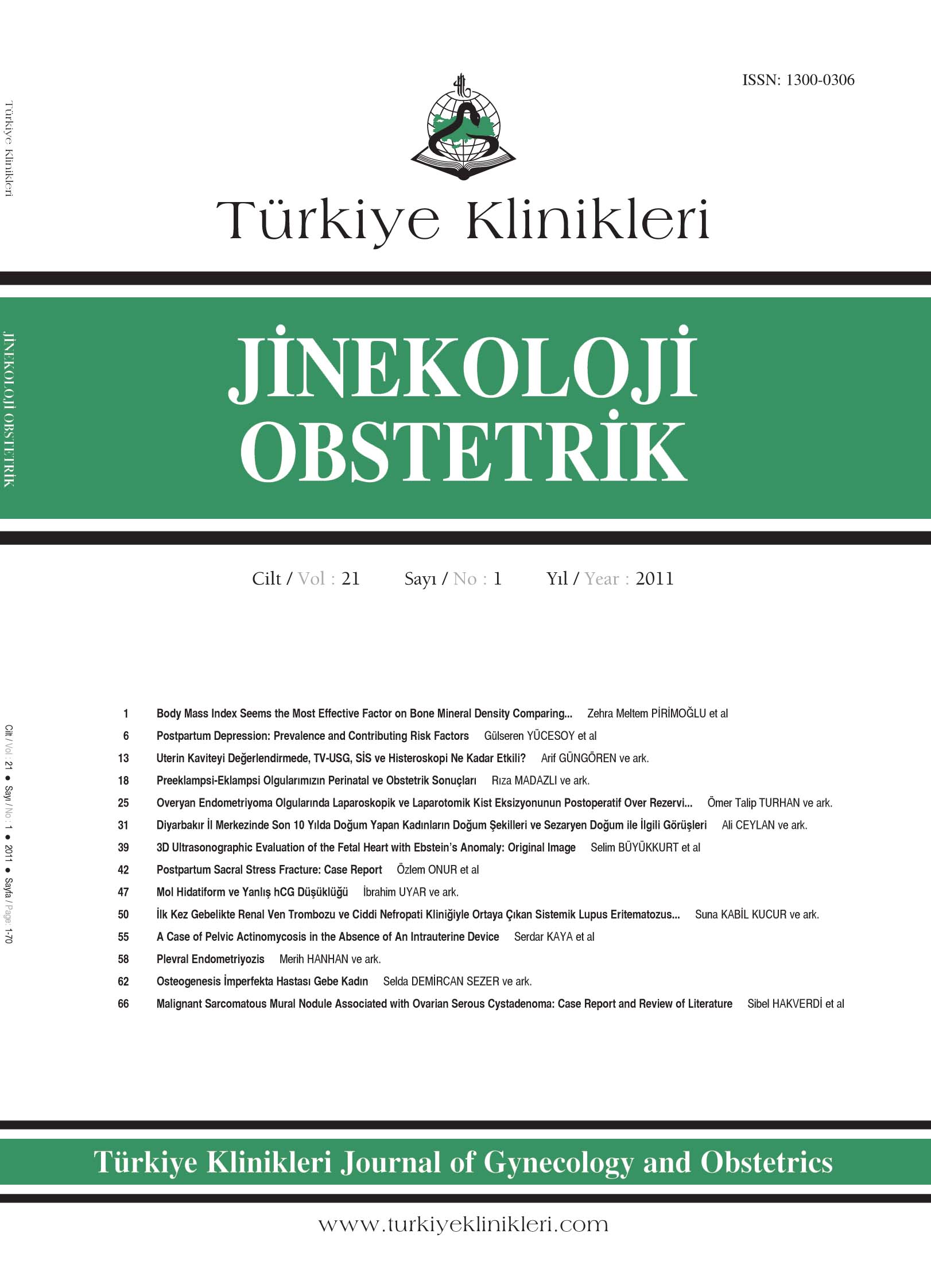Open Access
Peer Reviewed
ORIGINAL RESEARCH
1541 Viewed701 Downloaded
Body Mass Index Seems the Most Effective Factor on Bone Mineral Density Comparing Postmenopausal Time, Age or Reproductive Factors in Healthy Postmenopausal Women
Beden Kitle İndeksi; Sağlıklı Postmenopozal Kadınlarda, Menopoz Sonrası Süre, Yaş ya da Gebelik Hikâyesi Faktörlerine Kıyasla Kemik Mineral Yoğunluğu Üzerine En Etkin Faktör Olarak Gözükmektedir
Turkiye Klinikleri J Gynecol Obst. 2011;21(1):1-5
Article Language: EN
Copyright Ⓒ 2020 by Türkiye Klinikleri. This is an open access article under the CC BY-NC-ND license (http://creativecommons.org/licenses/by-nc-nd/4.0/)
ABSTRACT
Objective: The aim of this study is to determine risk factors on bone mineral density (BMD) in healthy postmenopausal Turkish women. We targeted to understand indications of measuring BMD in postmenopausal women and we tried to choose specific risk groups of them. So, we planned to prevent unnecessary BMD scanning. Material and Methods: A total of 260 postmenopausal women who visited our menopause clinic were included in this study. BMDs were determined by dual energy X-ray absorptiometry (DXA) at the lumbar spine and femur in all participants. We compared age, age at menopause, postmenopausal time, and number of pregnancy as risk factors. Results: Mean age, age at menopause, and duration since menopause was 48.0 ± 4.3 and 45.4 ± 4.4 years, 31.9 ± 32.4 months respectively. Mean body mass index (BMI) of patients was 28.5±4.5. BMD of lumbar spine (L2-L4) was 1.10 ± 0.16 g/cm<sup>2</sup> and femur was 0.93 ± 0.12 g/cm<sup>2</sup>. Mean parity was 3.6 ± 1.9. BMD was correlated to BMI positively. A negative correlation between BMD and parity was found significantly. Conclusion: This study revealed us that BMI and parity are important factors on BMD rather than age or time after menopause in postmenopausal women in Turkey.
Objective: The aim of this study is to determine risk factors on bone mineral density (BMD) in healthy postmenopausal Turkish women. We targeted to understand indications of measuring BMD in postmenopausal women and we tried to choose specific risk groups of them. So, we planned to prevent unnecessary BMD scanning. Material and Methods: A total of 260 postmenopausal women who visited our menopause clinic were included in this study. BMDs were determined by dual energy X-ray absorptiometry (DXA) at the lumbar spine and femur in all participants. We compared age, age at menopause, postmenopausal time, and number of pregnancy as risk factors. Results: Mean age, age at menopause, and duration since menopause was 48.0 ± 4.3 and 45.4 ± 4.4 years, 31.9 ± 32.4 months respectively. Mean body mass index (BMI) of patients was 28.5±4.5. BMD of lumbar spine (L2-L4) was 1.10 ± 0.16 g/cm<sup>2</sup> and femur was 0.93 ± 0.12 g/cm<sup>2</sup>. Mean parity was 3.6 ± 1.9. BMD was correlated to BMI positively. A negative correlation between BMD and parity was found significantly. Conclusion: This study revealed us that BMI and parity are important factors on BMD rather than age or time after menopause in postmenopausal women in Turkey.
ÖZET
Amaç: Çalışmanın amacı, menopoz sonrası kemik mineral yoğunluğu (KMY) üzerindeki risk faktörlerini Türk kadınlarında saptamaktır. Biz sağlıklı postmenopozal kadınlarda KMYyi ölçme endikasyonlarını anlamayı hedefledik ve spesifik risk gruplarını seçmeye çalıştık. Böylece gereksiz KMY ölçümünün önlenebileceğini planladık. Gereç ve Yöntemler: Menopoz kliniğimize başvuran toplam 260 postmenopozal kadın çalışma grubuna katıldı. Bütün katılımcıların "Dual energy X-ray absorptiometry (DXA)" ile lumbar ve femoral kemik dansiteleri saptandı. Biz yaş, menopoz yaşı, postmenopozal süre ve gebelik sayıları risk faktörleri olarak karşılaştırdık. Bulgular: Ortalama yaş, menopoz yaşı, postmenopozal süre sırasıyla 48.0 ± 4.3 ve 45.4 ± 4.4 yıl, 31.9 ± 32.4 aydı. Hastaların ortalama beden kitle indeksi (BKİ) 28.5 ± 4.5 ve lumbar ve femoral kemik dansitesi 1.10 ± 0.16 g/cm<sup>2</sup> ve 0.93 ± 0.12 g/cm<sup>2</sup> idi. Ortalama parite 3.6 ± 1.9 idi. KMY, BKİ ile pozitif korele idi. Parite ve KMY arasında anlamlı negatif korelasyonbulundu. Sonuç: Bu çalışma, bize gösterdi ki Türkiyede postmenopozal kadınlarda KMY üzerine BKİ ve parite; yaş ve postmenopozal süreye göre daha önemli faktörlerdir.
Amaç: Çalışmanın amacı, menopoz sonrası kemik mineral yoğunluğu (KMY) üzerindeki risk faktörlerini Türk kadınlarında saptamaktır. Biz sağlıklı postmenopozal kadınlarda KMYyi ölçme endikasyonlarını anlamayı hedefledik ve spesifik risk gruplarını seçmeye çalıştık. Böylece gereksiz KMY ölçümünün önlenebileceğini planladık. Gereç ve Yöntemler: Menopoz kliniğimize başvuran toplam 260 postmenopozal kadın çalışma grubuna katıldı. Bütün katılımcıların "Dual energy X-ray absorptiometry (DXA)" ile lumbar ve femoral kemik dansiteleri saptandı. Biz yaş, menopoz yaşı, postmenopozal süre ve gebelik sayıları risk faktörleri olarak karşılaştırdık. Bulgular: Ortalama yaş, menopoz yaşı, postmenopozal süre sırasıyla 48.0 ± 4.3 ve 45.4 ± 4.4 yıl, 31.9 ± 32.4 aydı. Hastaların ortalama beden kitle indeksi (BKİ) 28.5 ± 4.5 ve lumbar ve femoral kemik dansitesi 1.10 ± 0.16 g/cm<sup>2</sup> ve 0.93 ± 0.12 g/cm<sup>2</sup> idi. Ortalama parite 3.6 ± 1.9 idi. KMY, BKİ ile pozitif korele idi. Parite ve KMY arasında anlamlı negatif korelasyonbulundu. Sonuç: Bu çalışma, bize gösterdi ki Türkiyede postmenopozal kadınlarda KMY üzerine BKİ ve parite; yaş ve postmenopozal süreye göre daha önemli faktörlerdir.
MENU
POPULAR ARTICLES
MOST DOWNLOADED ARTICLES





This journal is licensed under a Creative Commons Attribution-NonCommercial-NoDerivatives 4.0 International License.











